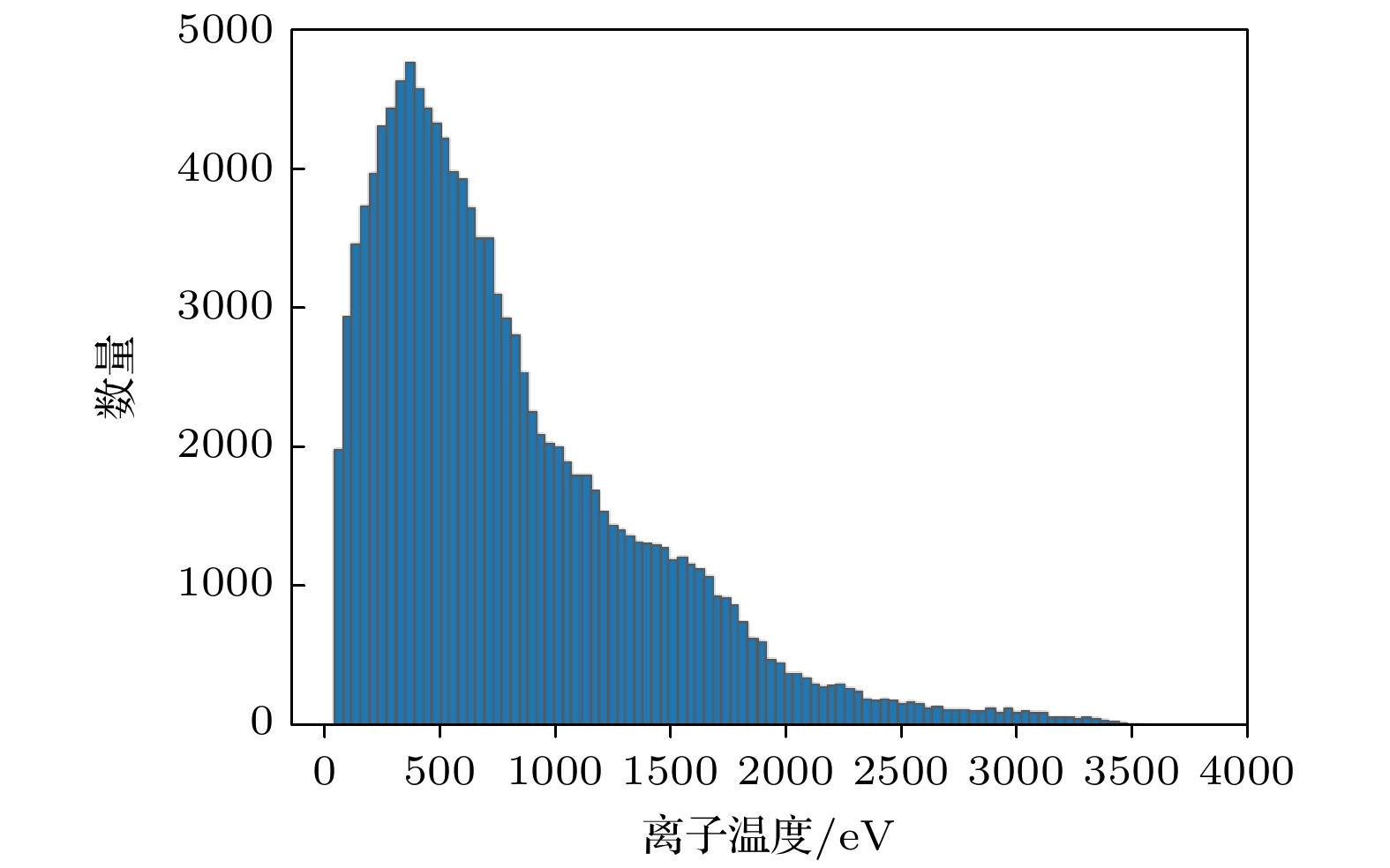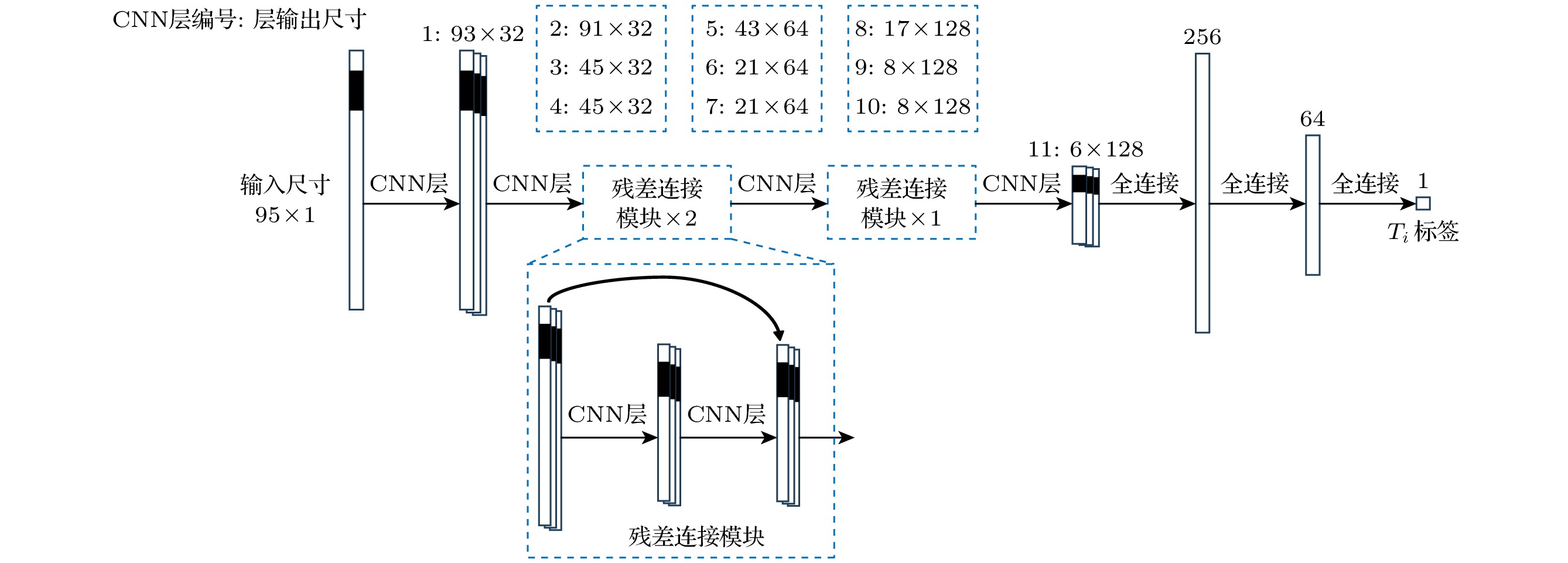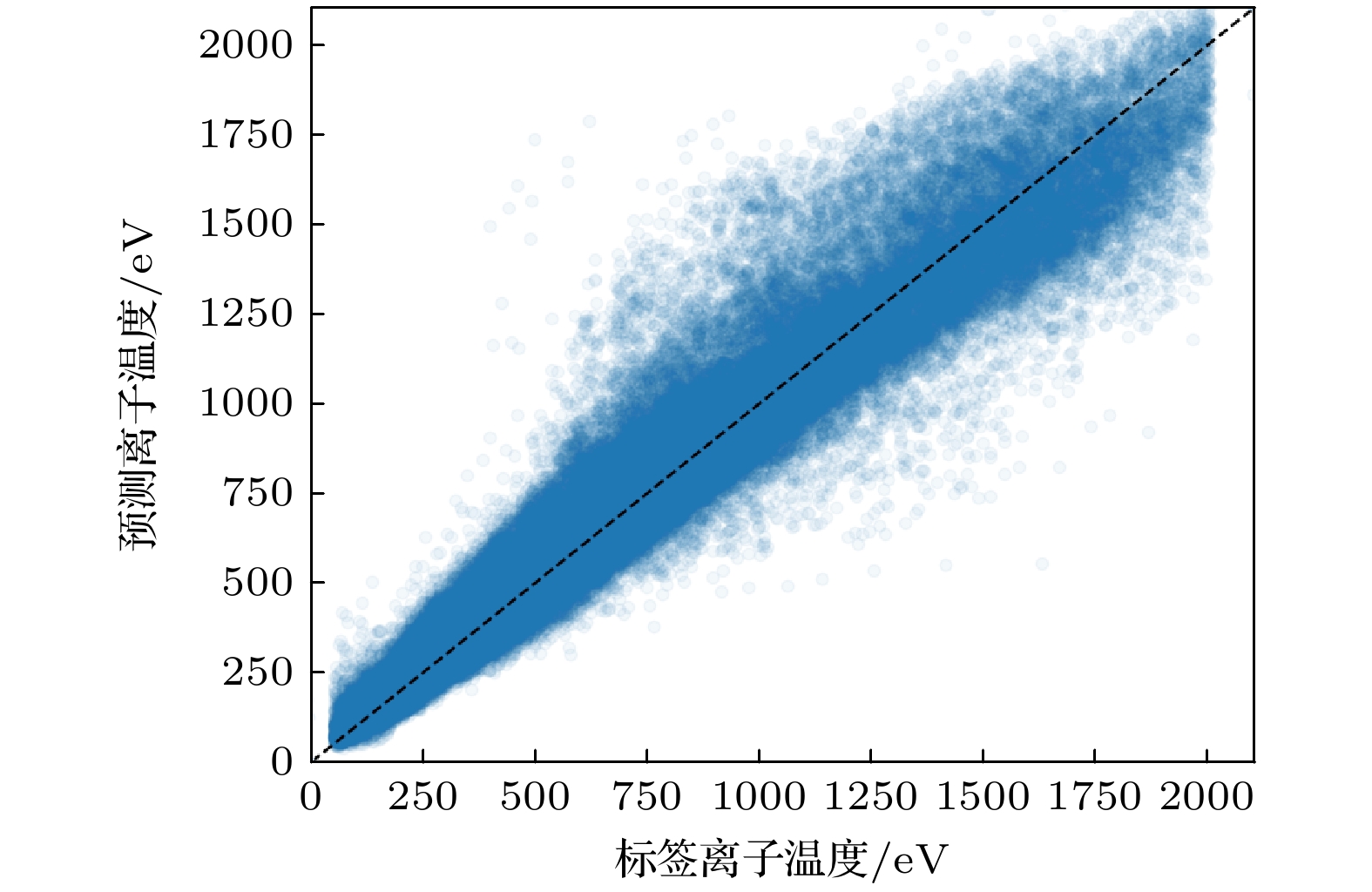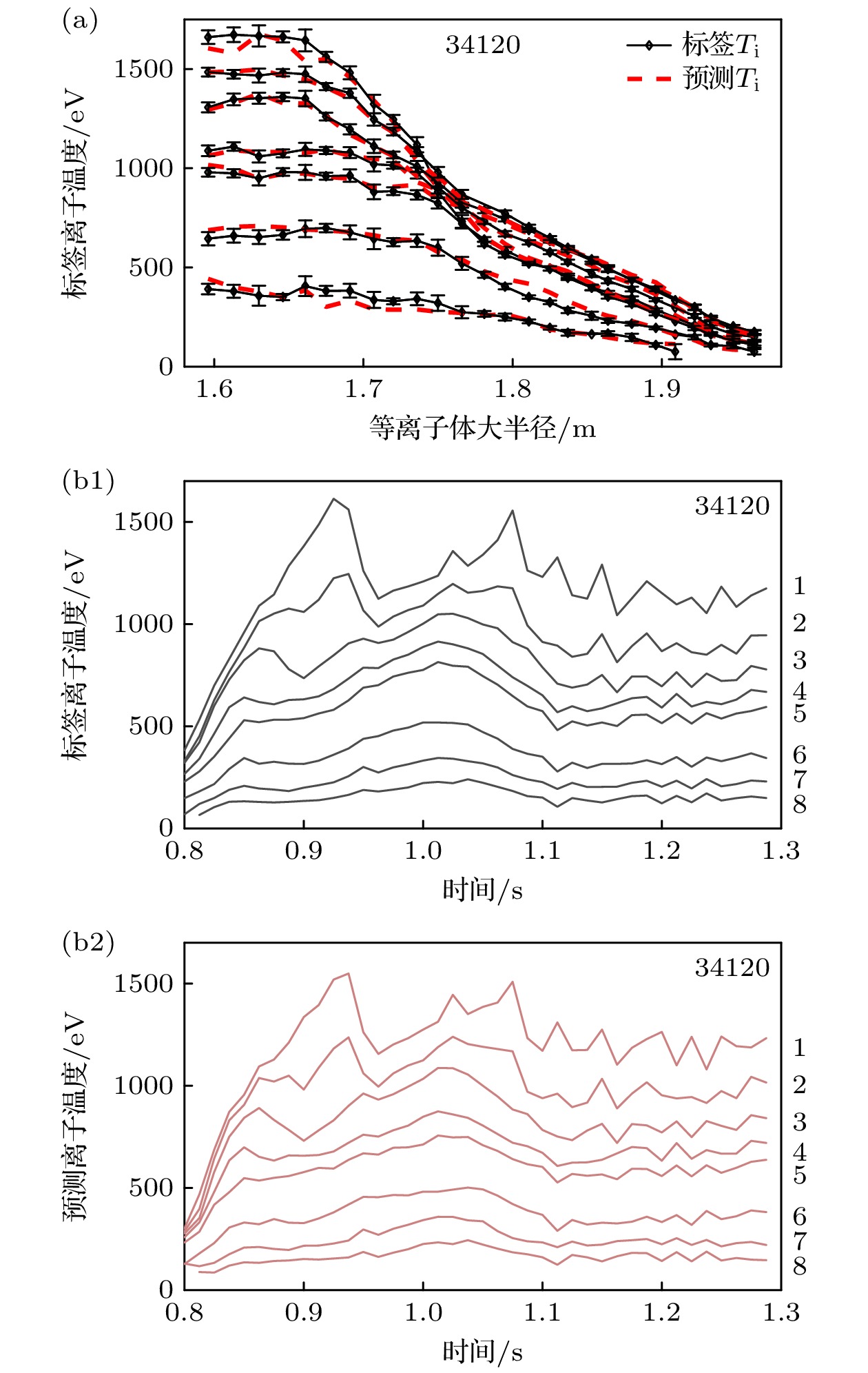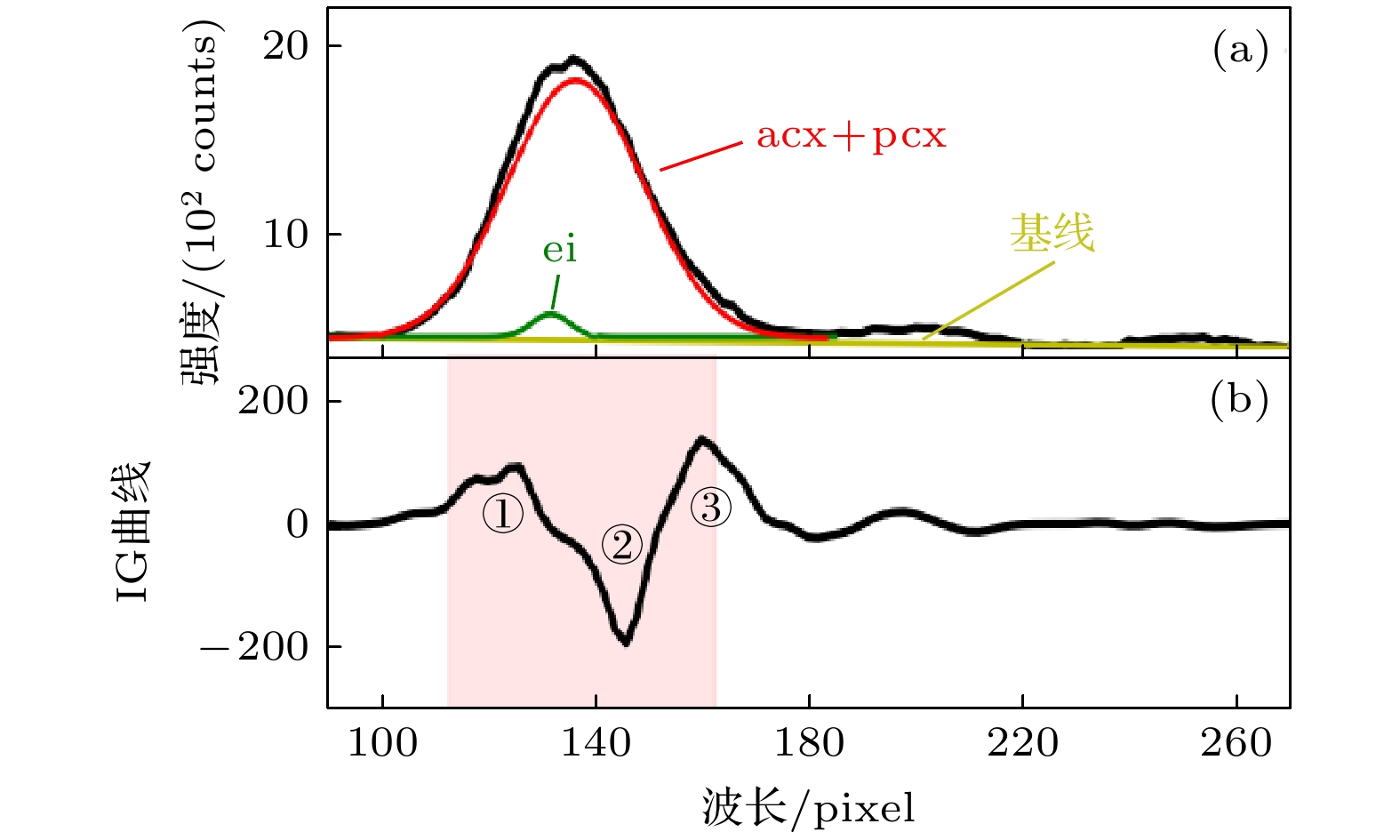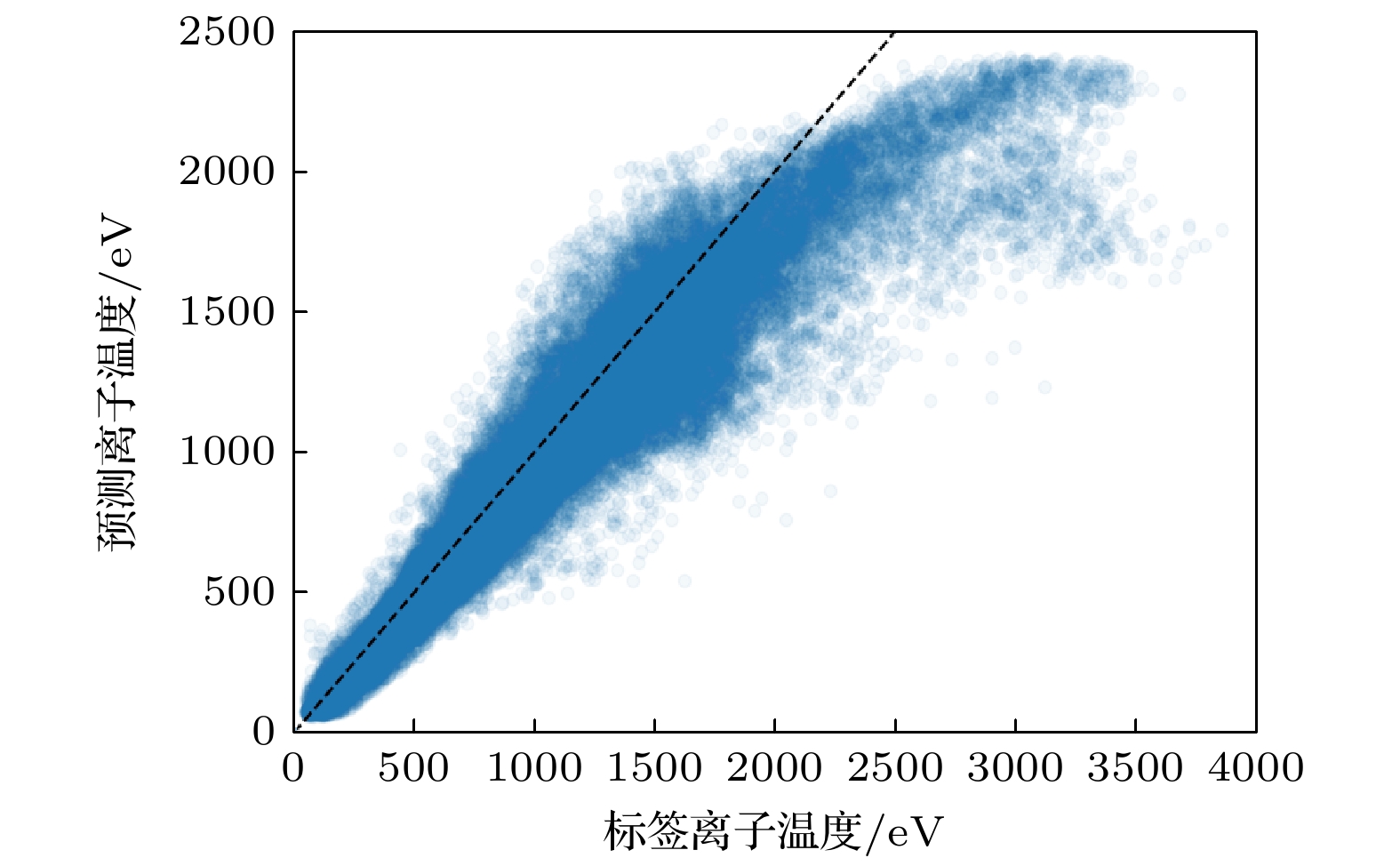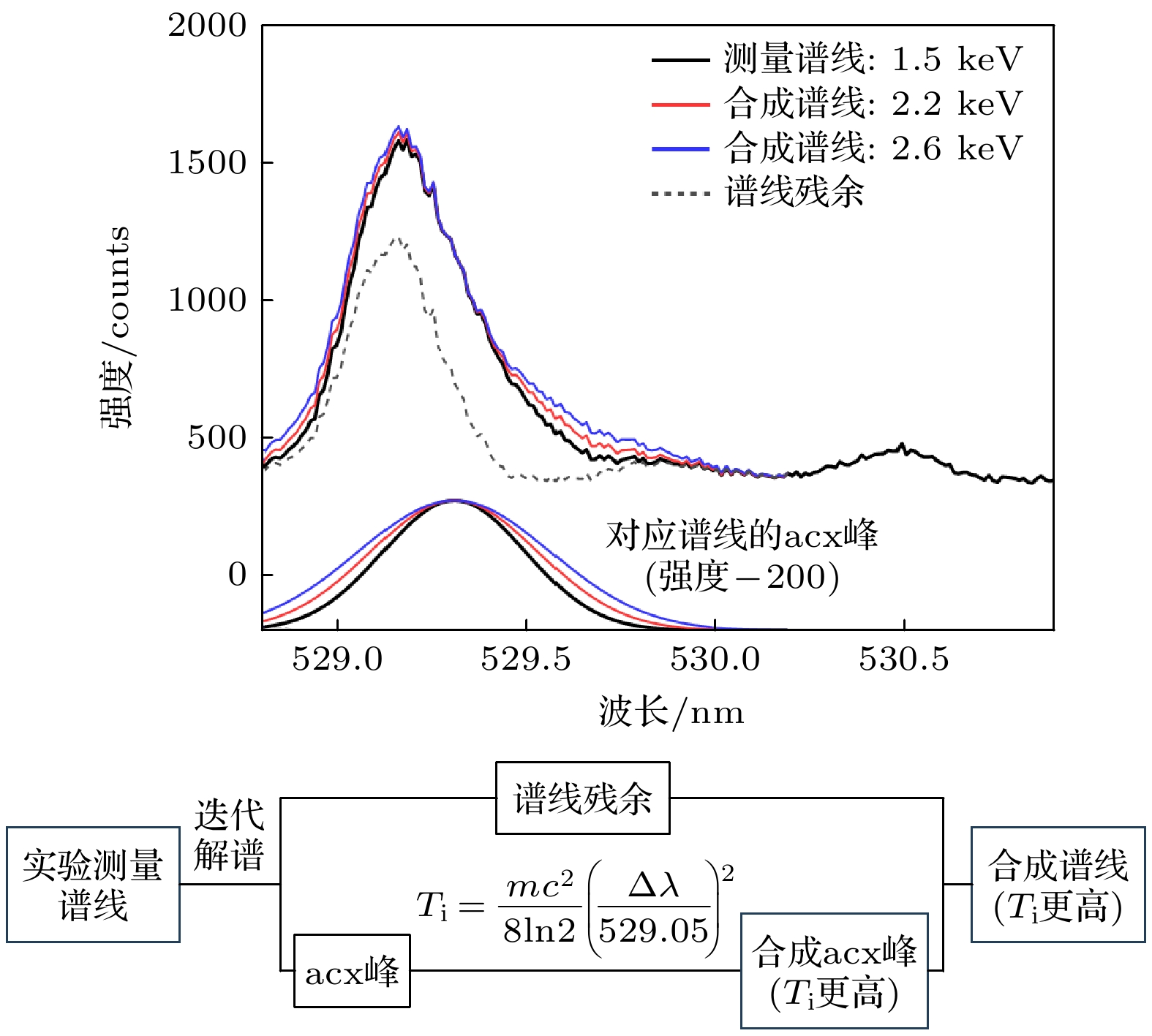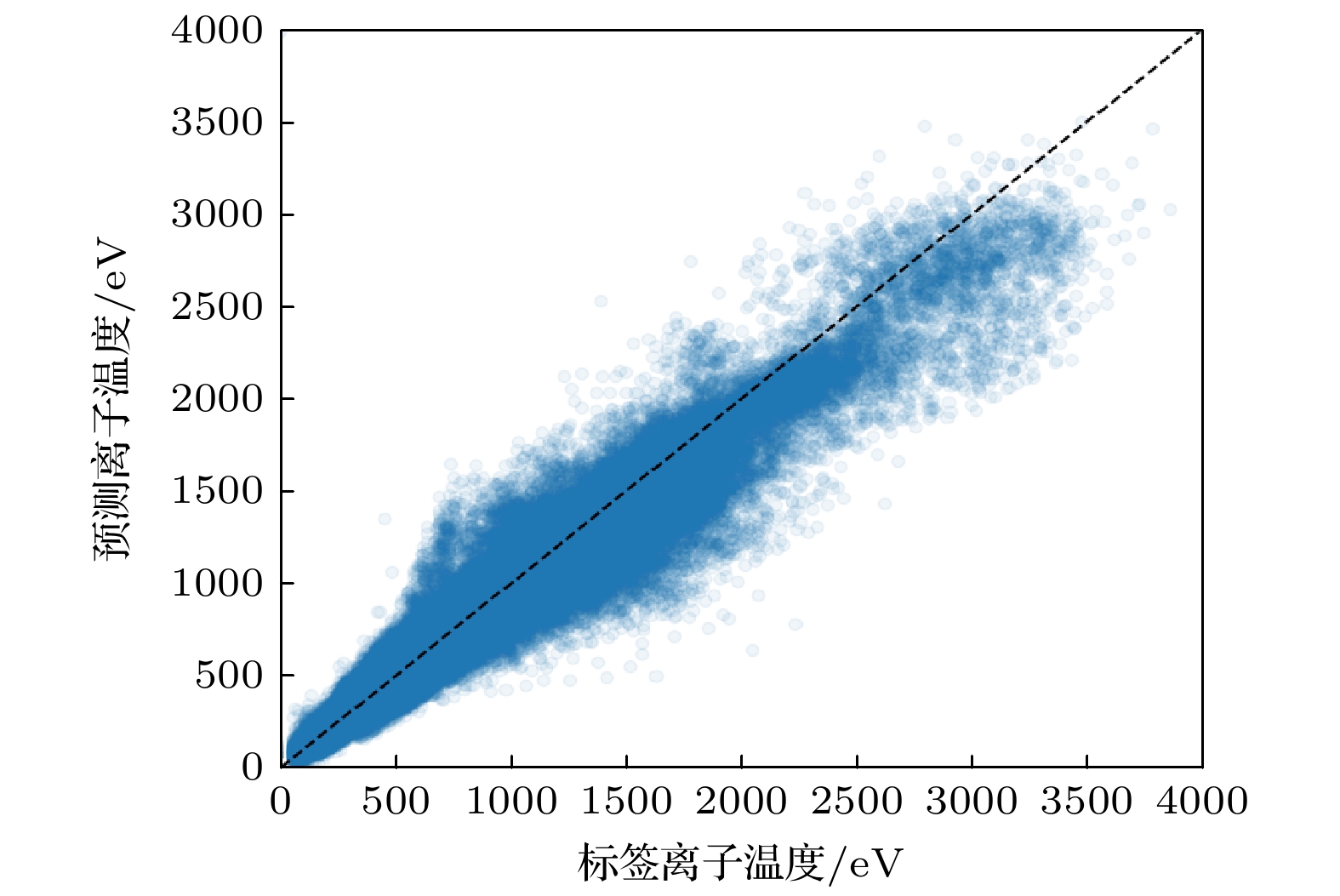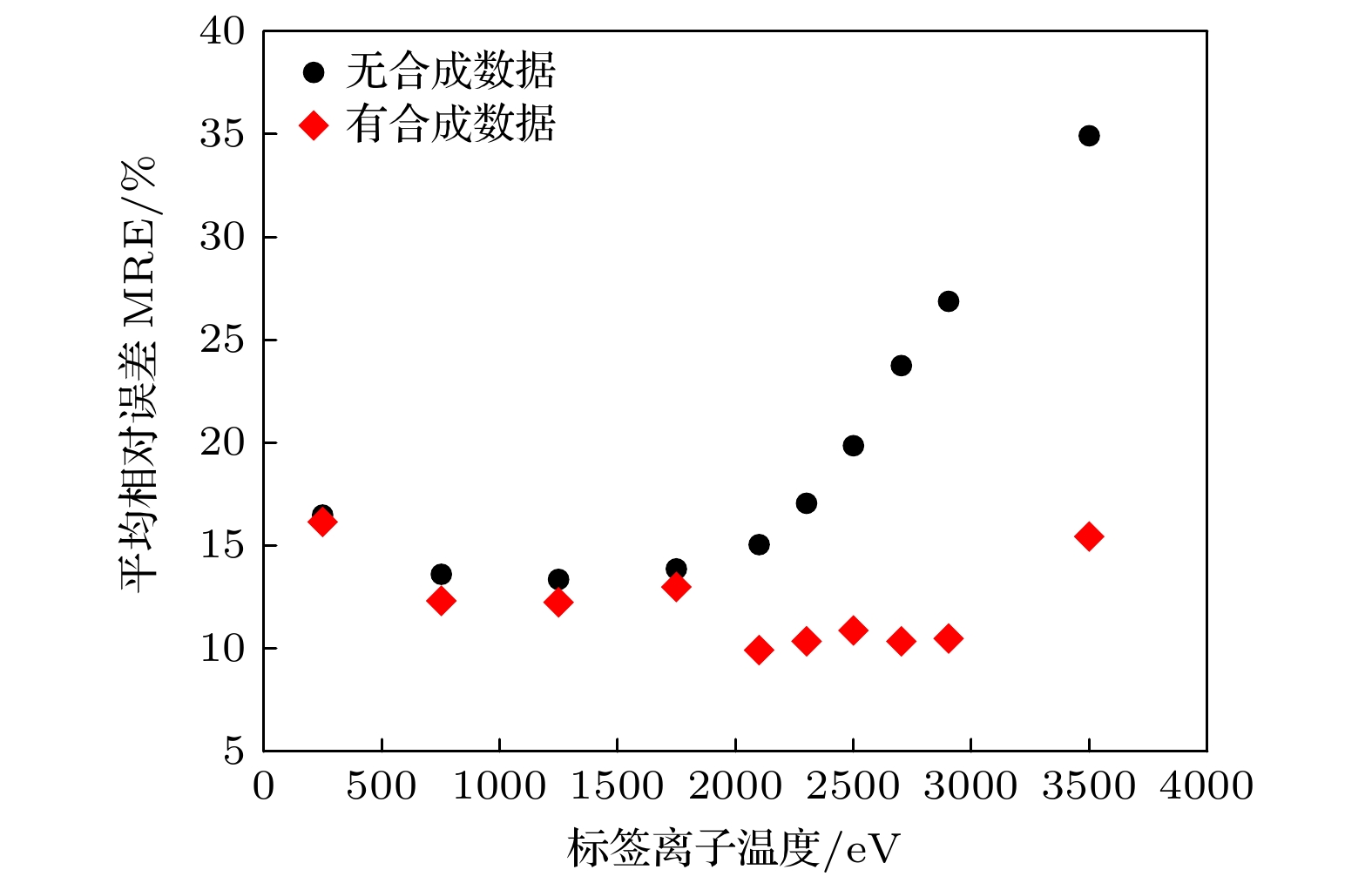-
Real-time measurement and feedback control of key plasma parameters are critical for future fusion reactor operation, with ion temperature being a vital control target as part of the triple product for fusion ignition. However, plasma diagnostics often require complex data analysis. A widely used method of obtaining ion temperature $ {T}_{{\mathrm{i}}} $ from charge exchange recombination spectroscopy (CXRS) is iterative spectral fitting, which is time-consuming and requires expert intervention during data analysis. Therefore, the traditional method cannot meet the demand for real-time $ {T}_{{\mathrm{i}}} $ measurement. Neural network (NN), which can learn the underlying relationships between the measured spectra and $ {T}_{{\mathrm{i}}} $, is a promising approach to cope with this problem. In fact, NN approach has been widely adopted in the field of magnetically confined plasma. Previous study in JET has achieved a satisfactory accuracy for inferring $ {T}_{{\mathrm{i}}} $ from CXRS spectra compared with the traditional fitting results. Recently, the study of disruption prediction has achieved great progress with the help of deep NNs. However, these researches are conducted on steadily-operating devices, where for NN models, the data distribution of training set is similar to that of test set. This is not the case for newly-built tokamaks like HL-3, nor for future fusion reactors such as ITER. For new devices, there will be a period for the plasma parameters to rise from low to high ranges. In this case, investigating the extrapolation capability of NN models based on low parameter training data is of paramount importance. A convolutional neural network (CNN)-based model is proposed to accelerate the analysis of spectral data of CXRS, with a focus on investigating the model’s extrapolation capability in a much higher $ {T}_{{\mathrm{i}}} $ range. The dataset contains about 122000 spectral data, as well as their corresponding $ {T}_{{\mathrm{i}}} $ inferred from offline iterative process. The results demonstrate that the CNN-based model achieves excellent analysis of $ {T}_{{\mathrm{i}}} $ as indicated by a coefficient of determination (R²) of 0.92, and reduces the inference time for analyzing a single spectrum to less than 1 ms, reaching 100–1000 times faster than traditional spectral fitting methods. However, the performance of the data-driven neural network model is limited by challenges such as insufficient data and imbalanced data distribution, which further deteriorates the extrapolation capability. Generally, data with higher $ {T}_{{\mathrm{i}}} $ account for a small portion of the total dataset. In our study, only about 5% of the spectra correspond to $ {T}_{{\mathrm{i}}} > 2{\mathrm{ }}\;{\mathrm{k}}{\mathrm{e}}{\mathrm{V}} $ (ranging from 2 to 4 keV). However, they reflect the temperature of central plasma, which is more important for assessing the performance of plasma. To overcome this limitation, this study synthesizes high-temperature data based on experimental data from discharges with $ {T}_{{\mathrm{i}}} $ in low-temperature range. By incorporating 5% synthetic data into the training set only consisting of data with $ {T}_{{\mathrm{i}}} < 2\;{\mathrm{ }}{\mathrm{k}}{\mathrm{e}}{\mathrm{V}} $, the model’s extrapolation capability is extended to cover the whole range of $ {T}_{{\mathrm{i}}} < 4\;{\mathrm{k}}{\mathrm{e}}{\mathrm{V}} $. The mean relative error (MRE) of the model in the range of $ {3\;{\mathrm{ }}{\mathrm{k}}{\mathrm{e}}{\mathrm{V}} < T}_{{\mathrm{i}}} < 4\;{\mathrm{k}}{\mathrm{e}}{\mathrm{V}} $ is reduced from 35% to below 15%, corresponding to a reduction of approximately 60% relative to the MRE before adding synthetic data. This approach demonstrates the feasibility of using synthetic data to enhance the performance of artificial intelligence algorithms in the field of magnetic confinement fusion. These findings provide valuable insights for the development of real-time ion temperature measurement and feedback control for future high-parameter fusion devices. Furthermore, the study lays a foundation for research in areas that require high-performance cross-device characteristic, such as machine learning-based disruption prediction and tearing mode control. -
Keywords:
- plasma /
- neural network /
- extrapolation capability /
- spectral diagnostic
[1] Lister J B, Bruzzone P L, Costley A E, et al. 2000 Nucl. Fusion 40 1167
 Google Scholar
Google Scholar
[2] Gormezano C, Sips A C C, Luce T C, et al. 2007 Nucl. Fusion 47 S285
 Google Scholar
Google Scholar
[3] Hellermann M G V, Mandl W, Summers H P, Weisen H, Wolf R 1990 Rev. Sci. Instrum. 61 3479
 Google Scholar
Google Scholar
[4] Seraydarian R P, Burrell K H 1986 Rev. Sci. Instrum. 57 2012
 Google Scholar
Google Scholar
[5] 何小雪, 陈文锦, 魏彦玲, 刘亮, 王诗琴, 余德良 2024 核聚变与等离子体物理 44 477
 Google Scholar
Google Scholar
He X X, Chen W J, Wei Y L, Liu L, Wang S Q, Yu D L 2024 Nucl. Fusion Plasma Phys. 44 477
 Google Scholar
Google Scholar
[6] 张镱 2015 硕士学位论文(合肥: 中国科学技术大学)
Zhang Y 2015 M. S. Thesis (Hefei: University of Science and Technology of China
[7] Svensson J, Hellermann M V, König R W T 1999 Plasma Phys. Controlled Fusion 41 315
 Google Scholar
Google Scholar
[8] Bishop C M, Roach C M 1992 Rev. Sci. Instrum. 63 4450
 Google Scholar
Google Scholar
[9] Abbate J, Conlin R, Kolemen E 2021 Nucl. Fusion 61 046027
 Google Scholar
Google Scholar
[10] Zheng G H, Yang Z Y, Liu S F, Ma R, Gong X W, Wang A, Wang S, Zhong W L 2024 Nucl. Fusion 64 126041
 Google Scholar
Google Scholar
[11] Yang Z, Xia F, Song X, Gao Z, Wang S, Dong Y 2021 Nucl. Fusion 61 126042
 Google Scholar
Google Scholar
[12] Yang Z, Xia F, Song X, et al. 2022 Fusion Eng. Des. 182 113223
 Google Scholar
Google Scholar
[13] Seo J, Kim S, Jalalvand A, et al. 2024 Nature 626 8000
 Google Scholar
Google Scholar
[14] Duan X R, Xu M, Zhong W L, et al. 2024 Nucl. Fusion 64 112021
 Google Scholar
Google Scholar
[15] Duan X R, Xu M, Zhong W L, et al. 2022 Nucl. Fusion 62 042020
 Google Scholar
Google Scholar
[16] Donné A J H, Costley A E, Barnsley R, et al. 2007 Nucl. Fusion 47 S337
 Google Scholar
Google Scholar
[17] Wei Y L, Yu D L, Liu L, et al. 2014 Rev. Sci. Instrum. 85 103503
 Google Scholar
Google Scholar
[18] He X X, Yu D L, Yan L W, et al. 2020 Rev. Sci. Instrum. 91 053504
 Google Scholar
Google Scholar
[19] 王彦飞, 朱悉铭, 张明志, 孟圣峰, 贾军伟, 柴昊, 王旸, 宁中喜 2021 70 095211
 Google Scholar
Google Scholar
Wang Y F, Zhu X M, Zhang M Z, Meng S F, Jia J W, Chai H, Wang Y, Ning Z X 2021 Acta Phys. Sin. 70 095211
 Google Scholar
Google Scholar
[20] Fei N Y, Gao Y Z, Lu Z W, Xiang T 2021 2021 IEEE/CVF International Conference on Computer Vision Electric Network, October 11–17, 2021 pp142–151
[21] He K M, Zhang X Y, Ren S Q, Sun J 2016 IEEE Conference on Computer Vision and Pattern Recognition Las Vegas, June 27–30, 2016 pp770–778
[22] He M, Yang Z, Liu S, Xia F, Zhong W 2024 Plasma Phys. Controlled Fusion 66 105019
 Google Scholar
Google Scholar
[23] Hendrycks D, Gimpel K 2016 arXiv: 1606.08415 [cs. LG]
[24] Loshchilov I, Hutter F 2017 arXiv: 1711.05101 [cs. LG]
[25] Yushmanov P N, Takizuka T, Riedel K S, Kardaun O J W F, Cordey J G, Kaye S M, Post D E 1990 Nucl. Fusion 30 1999
 Google Scholar
Google Scholar
[26] Sundararajan M, Taly A, Yan Q 2017 arXiv: 1703.01365 [cs. LG]
-
图 6 光谱曲线及对应的IG曲线(炮号34339, 810 ms). 神经网络对输入的IG曲线呈现近似“M”型, 且与高斯峰的位置准确吻合, 呈现出检测高斯峰的行为
Figure 6. The spectrum and IG graph of the spectrum in 810 ms of shot No. 34339. The neural network presents an approximate “M” shape to the input IG curve, and it is exactly consistent with the position of the Gaussian peak, showing the behavior of detecting the Gaussian peak
表 1 CNN层的参数配置
Table 1. Configuration of the CNN layers.
编号 核数量 核宽度 激活函数 池化 池化步长 池化宽度 1 32 3 gelu[23] — — — 2 32 3 最大 2 2 3 32 3 — — — 4 32 3 — — — 5 64 3 最大 2 2 6 64 3 — — — 7 64 3 — — — 8 128 5 最大 2 2 9 128 3 — — — 10 128 3 — — — 11 128 3 最大 — 全局 表 2 模型训练过程的超参数配置及相关说明
Table 2. Hyper-parameters and related explanation of the CNN-based model.
参数(英文名) 值 说明 高斯噪声(Gaussian noise) μ = 0, σ = 0.01 添加高斯噪声对训练集进行数据增强 批次尺寸(Batch size) 128 随机梯度下降过程中的批次数据个数 早停机制(Early stopping) 20 经过一定轮次的训练若效果不再提升则视为训练完成 神经元屏蔽(Dropout) 0.2 全连接层中神经元输出在训练过程中随机置零的比例, 以减少过拟合 表 3 模型的拟合效果及速度评估
Table 3. Performance of the model.
训练集 测试集/keV $ {R}^{2} $ MRE 推理耗时/
(ms·单光谱–1)无合成数据 0—2 0.92 14% 0.59
(平均值)0.67
(99%)无合成数据 0—4 0.86 15% 有合成数据 0—4 0.93 13% -
[1] Lister J B, Bruzzone P L, Costley A E, et al. 2000 Nucl. Fusion 40 1167
 Google Scholar
Google Scholar
[2] Gormezano C, Sips A C C, Luce T C, et al. 2007 Nucl. Fusion 47 S285
 Google Scholar
Google Scholar
[3] Hellermann M G V, Mandl W, Summers H P, Weisen H, Wolf R 1990 Rev. Sci. Instrum. 61 3479
 Google Scholar
Google Scholar
[4] Seraydarian R P, Burrell K H 1986 Rev. Sci. Instrum. 57 2012
 Google Scholar
Google Scholar
[5] 何小雪, 陈文锦, 魏彦玲, 刘亮, 王诗琴, 余德良 2024 核聚变与等离子体物理 44 477
 Google Scholar
Google Scholar
He X X, Chen W J, Wei Y L, Liu L, Wang S Q, Yu D L 2024 Nucl. Fusion Plasma Phys. 44 477
 Google Scholar
Google Scholar
[6] 张镱 2015 硕士学位论文(合肥: 中国科学技术大学)
Zhang Y 2015 M. S. Thesis (Hefei: University of Science and Technology of China
[7] Svensson J, Hellermann M V, König R W T 1999 Plasma Phys. Controlled Fusion 41 315
 Google Scholar
Google Scholar
[8] Bishop C M, Roach C M 1992 Rev. Sci. Instrum. 63 4450
 Google Scholar
Google Scholar
[9] Abbate J, Conlin R, Kolemen E 2021 Nucl. Fusion 61 046027
 Google Scholar
Google Scholar
[10] Zheng G H, Yang Z Y, Liu S F, Ma R, Gong X W, Wang A, Wang S, Zhong W L 2024 Nucl. Fusion 64 126041
 Google Scholar
Google Scholar
[11] Yang Z, Xia F, Song X, Gao Z, Wang S, Dong Y 2021 Nucl. Fusion 61 126042
 Google Scholar
Google Scholar
[12] Yang Z, Xia F, Song X, et al. 2022 Fusion Eng. Des. 182 113223
 Google Scholar
Google Scholar
[13] Seo J, Kim S, Jalalvand A, et al. 2024 Nature 626 8000
 Google Scholar
Google Scholar
[14] Duan X R, Xu M, Zhong W L, et al. 2024 Nucl. Fusion 64 112021
 Google Scholar
Google Scholar
[15] Duan X R, Xu M, Zhong W L, et al. 2022 Nucl. Fusion 62 042020
 Google Scholar
Google Scholar
[16] Donné A J H, Costley A E, Barnsley R, et al. 2007 Nucl. Fusion 47 S337
 Google Scholar
Google Scholar
[17] Wei Y L, Yu D L, Liu L, et al. 2014 Rev. Sci. Instrum. 85 103503
 Google Scholar
Google Scholar
[18] He X X, Yu D L, Yan L W, et al. 2020 Rev. Sci. Instrum. 91 053504
 Google Scholar
Google Scholar
[19] 王彦飞, 朱悉铭, 张明志, 孟圣峰, 贾军伟, 柴昊, 王旸, 宁中喜 2021 70 095211
 Google Scholar
Google Scholar
Wang Y F, Zhu X M, Zhang M Z, Meng S F, Jia J W, Chai H, Wang Y, Ning Z X 2021 Acta Phys. Sin. 70 095211
 Google Scholar
Google Scholar
[20] Fei N Y, Gao Y Z, Lu Z W, Xiang T 2021 2021 IEEE/CVF International Conference on Computer Vision Electric Network, October 11–17, 2021 pp142–151
[21] He K M, Zhang X Y, Ren S Q, Sun J 2016 IEEE Conference on Computer Vision and Pattern Recognition Las Vegas, June 27–30, 2016 pp770–778
[22] He M, Yang Z, Liu S, Xia F, Zhong W 2024 Plasma Phys. Controlled Fusion 66 105019
 Google Scholar
Google Scholar
[23] Hendrycks D, Gimpel K 2016 arXiv: 1606.08415 [cs. LG]
[24] Loshchilov I, Hutter F 2017 arXiv: 1711.05101 [cs. LG]
[25] Yushmanov P N, Takizuka T, Riedel K S, Kardaun O J W F, Cordey J G, Kaye S M, Post D E 1990 Nucl. Fusion 30 1999
 Google Scholar
Google Scholar
[26] Sundararajan M, Taly A, Yan Q 2017 arXiv: 1703.01365 [cs. LG]
Catalog
Metrics
- Abstract views: 3275
- PDF Downloads: 58
- Cited By: 0














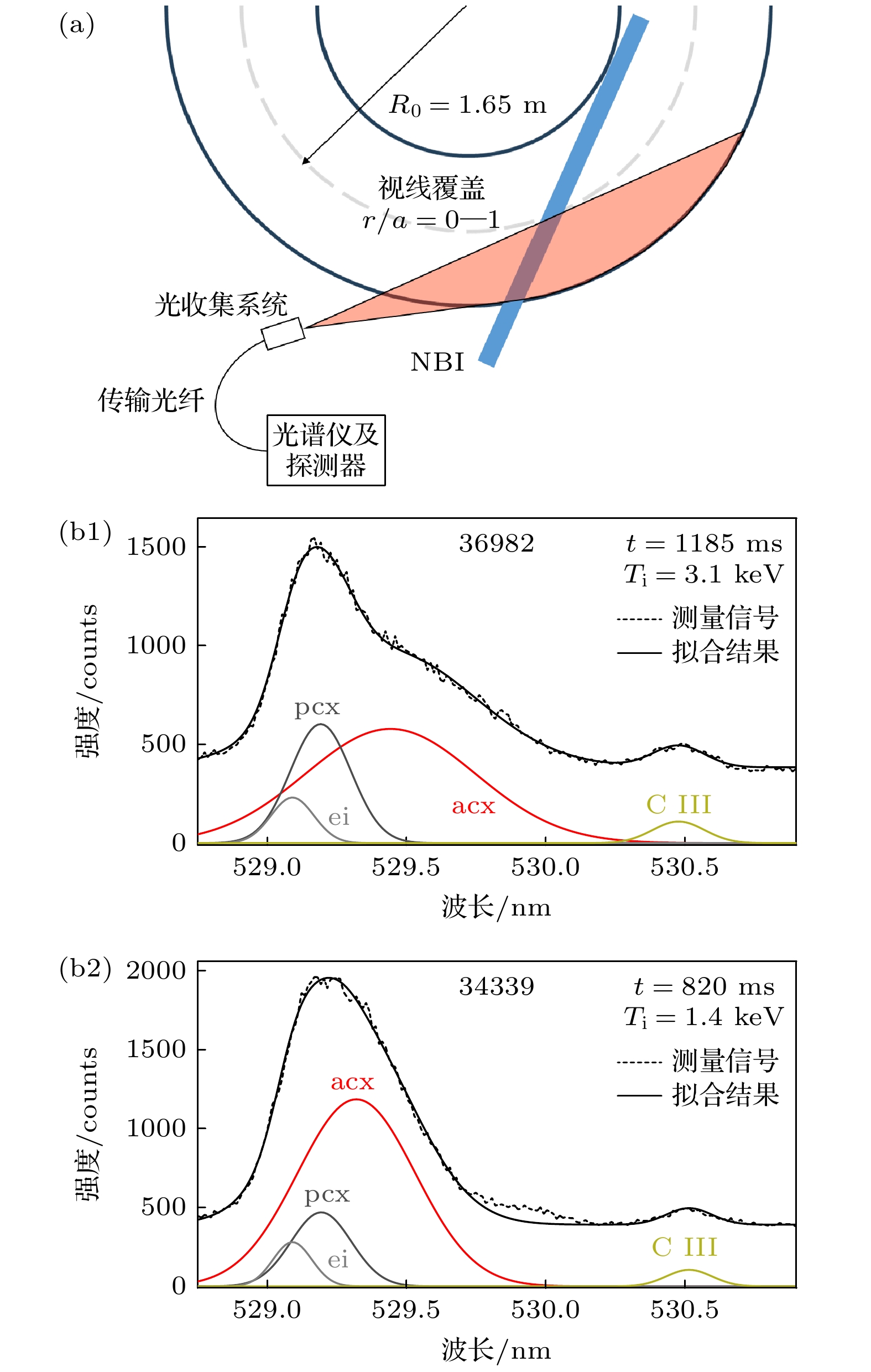
 DownLoad:
DownLoad:
